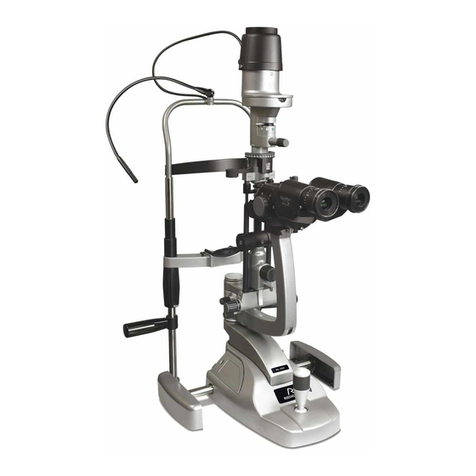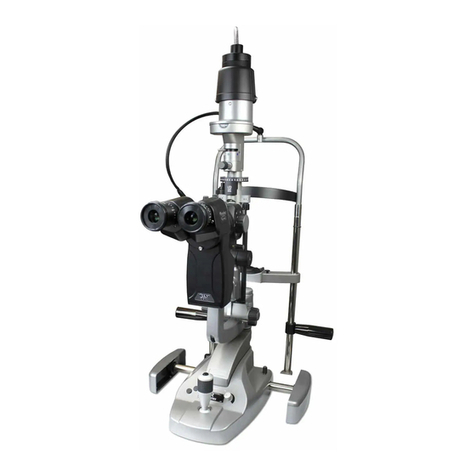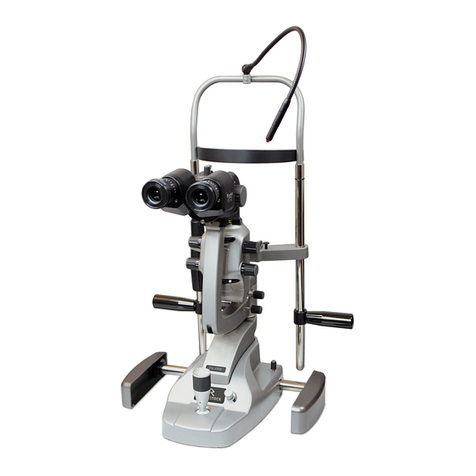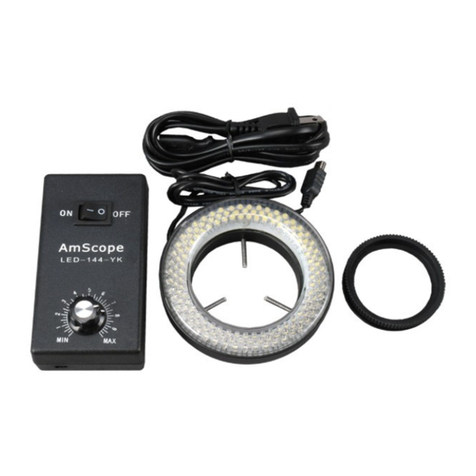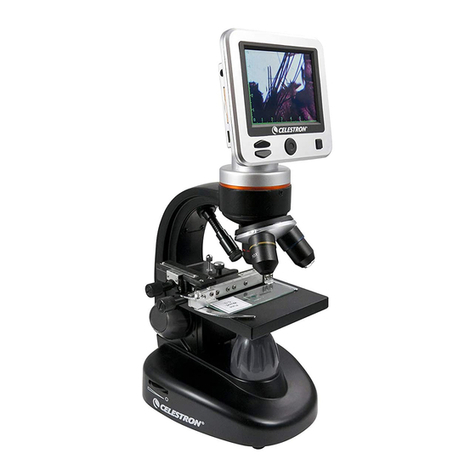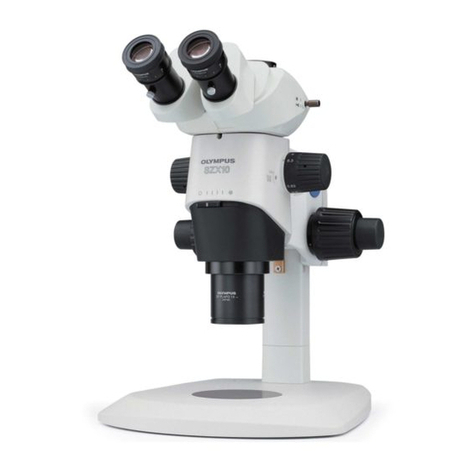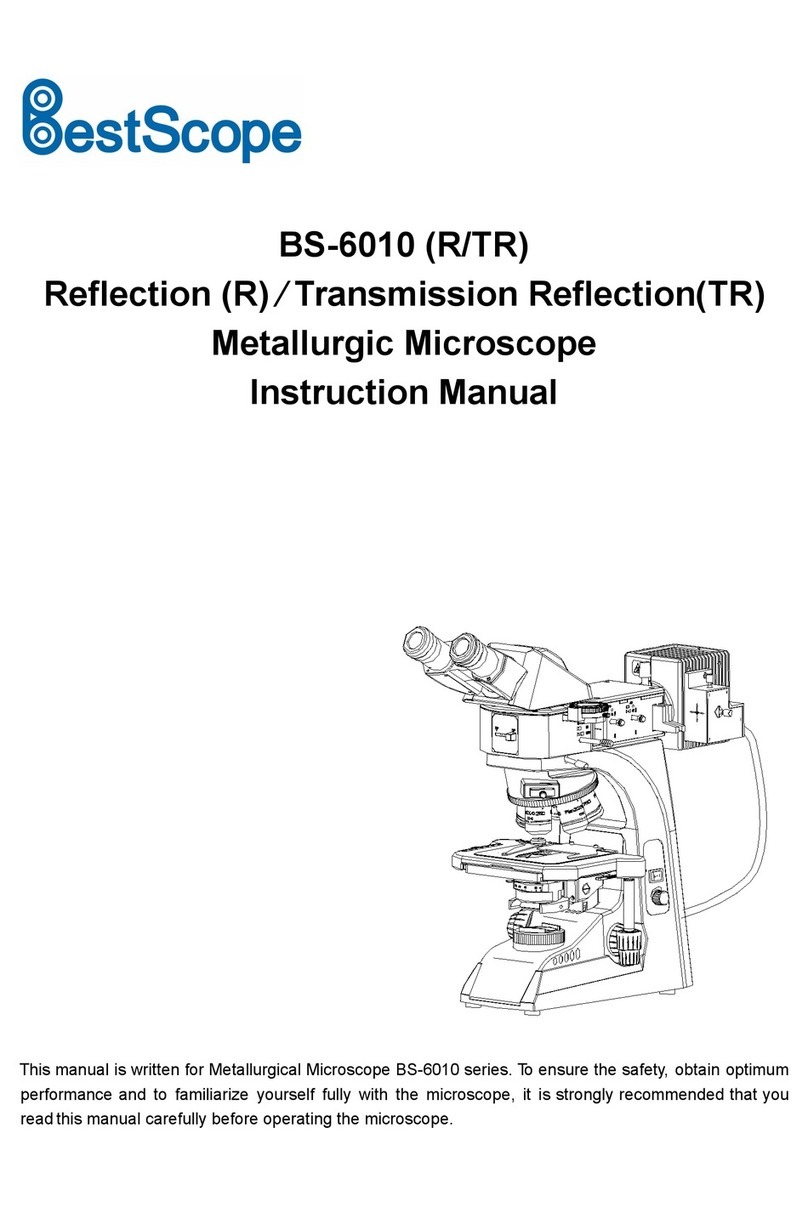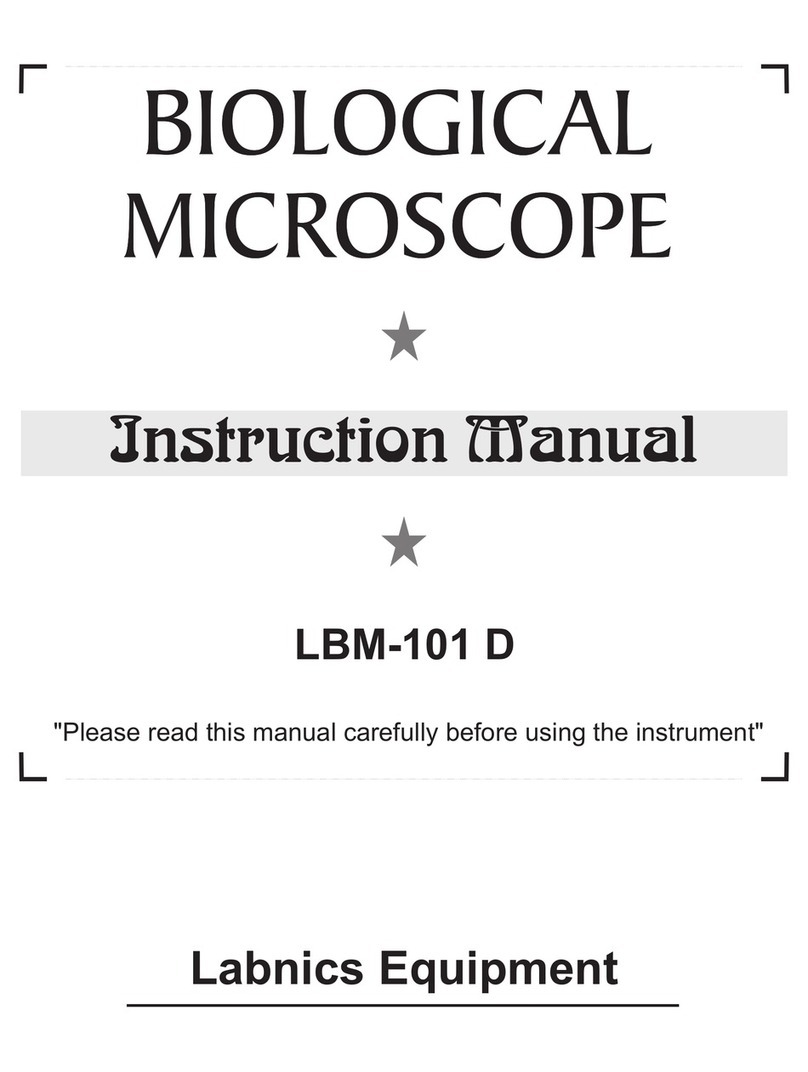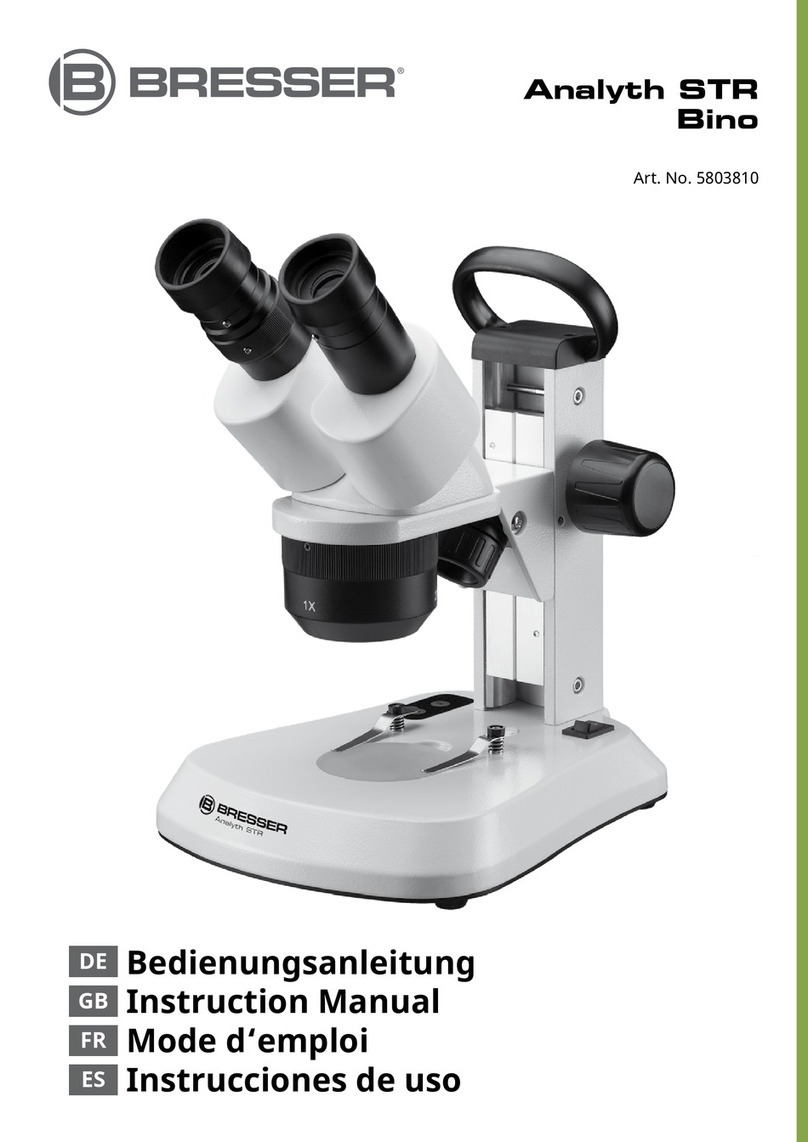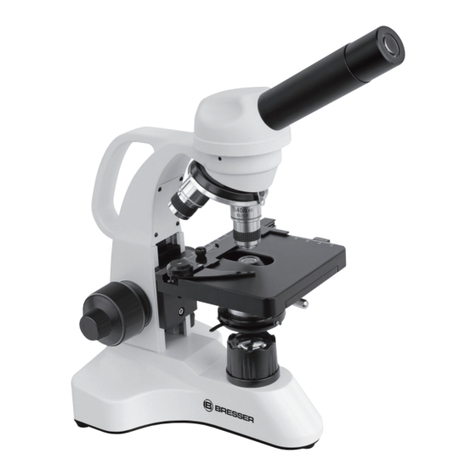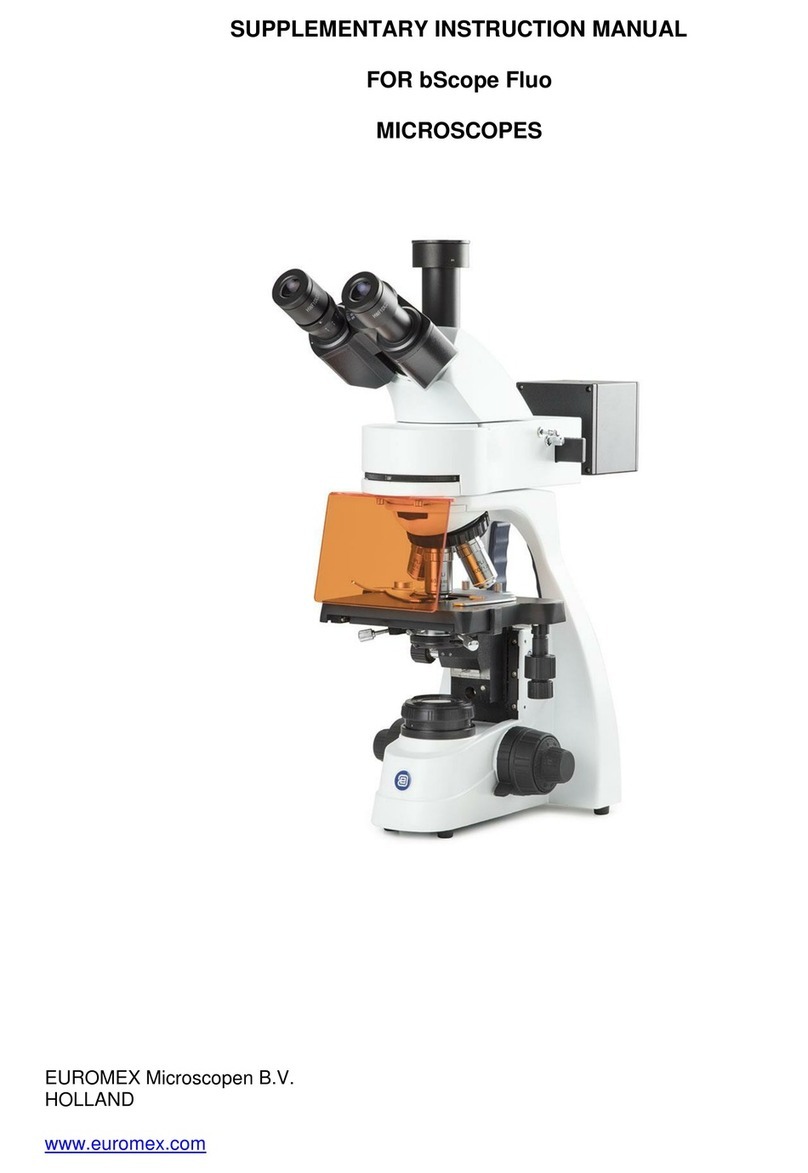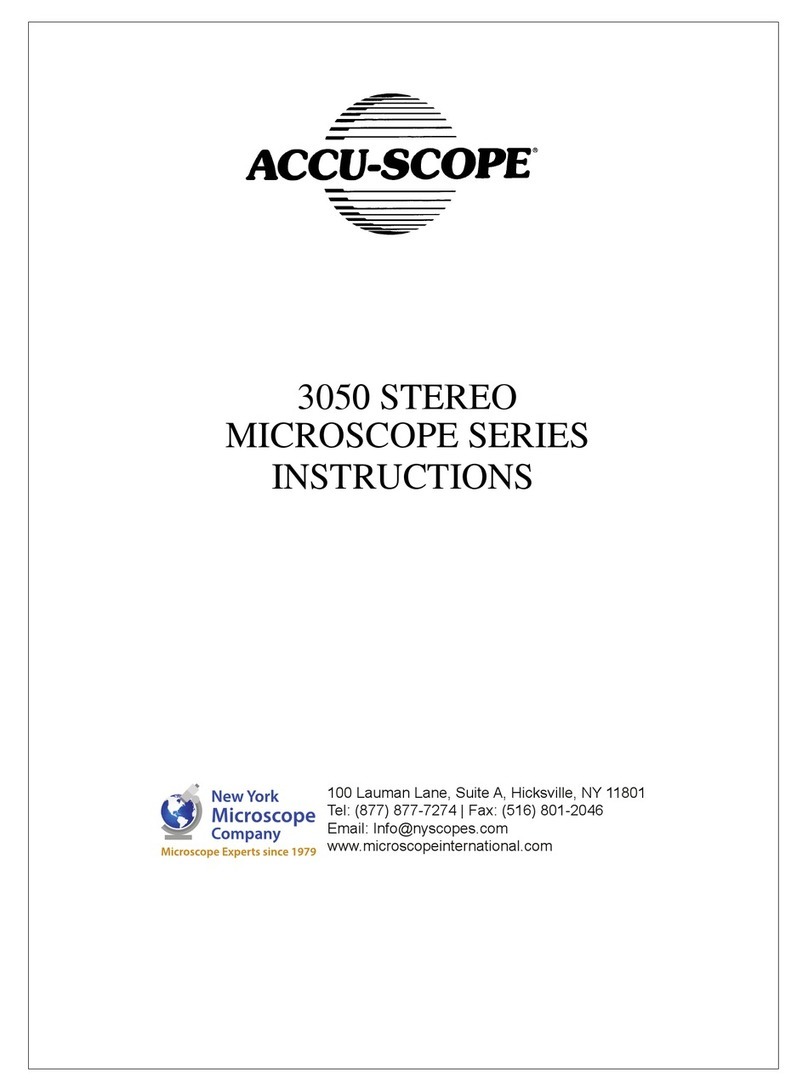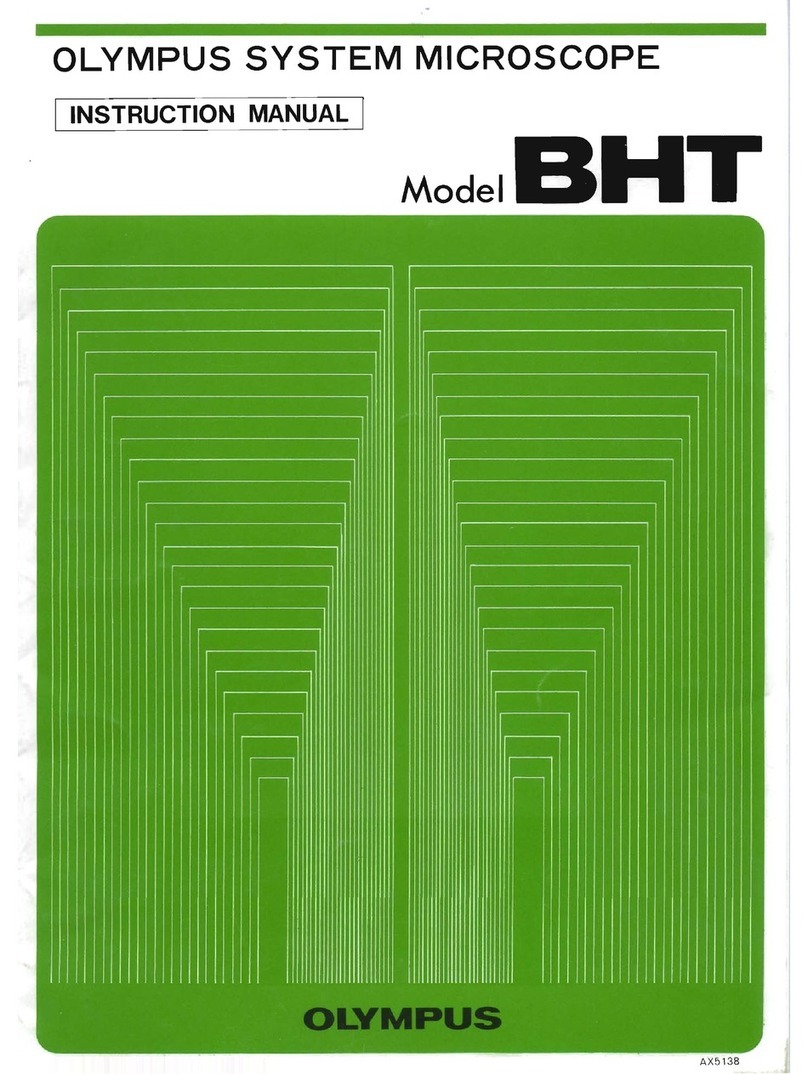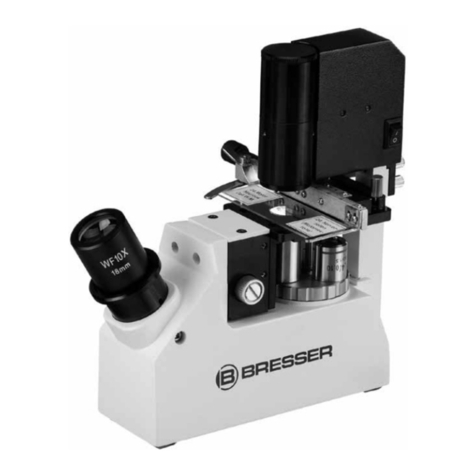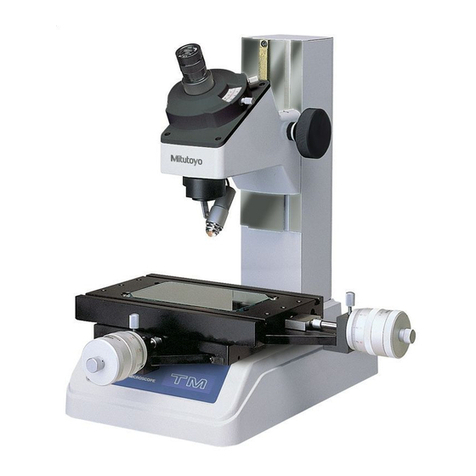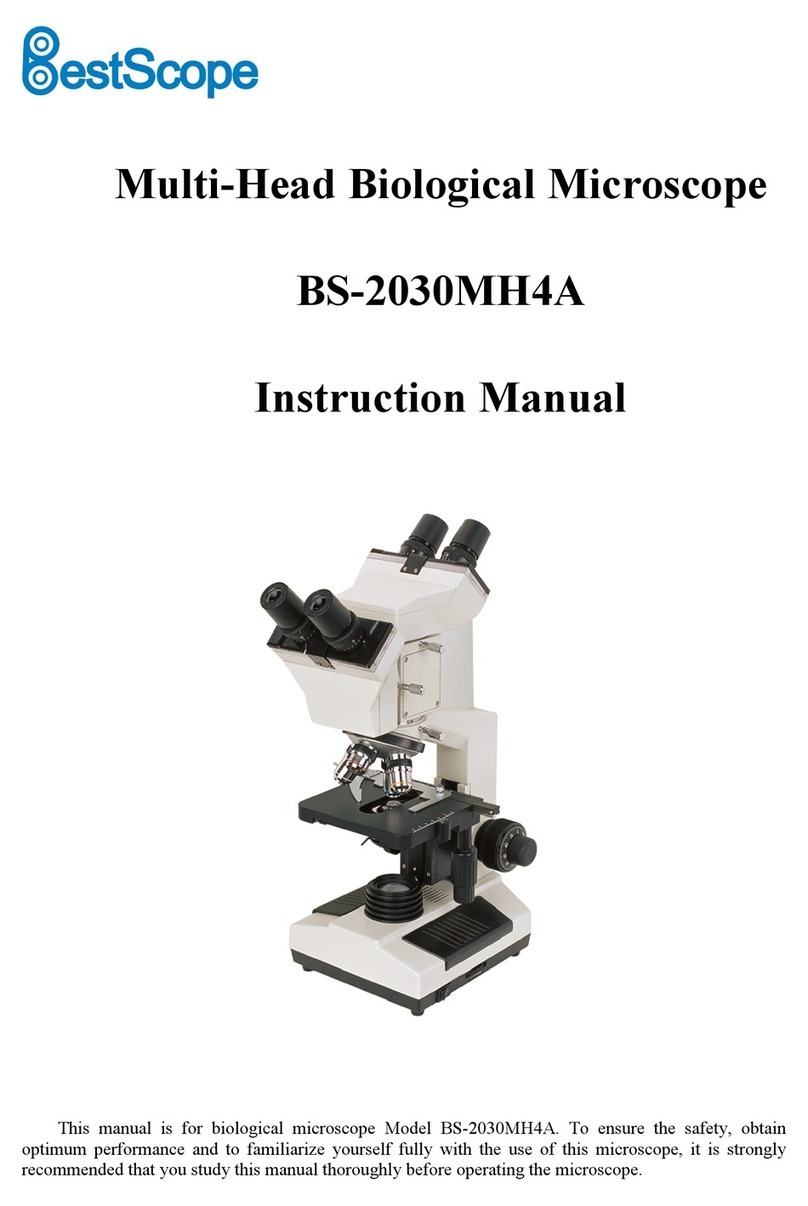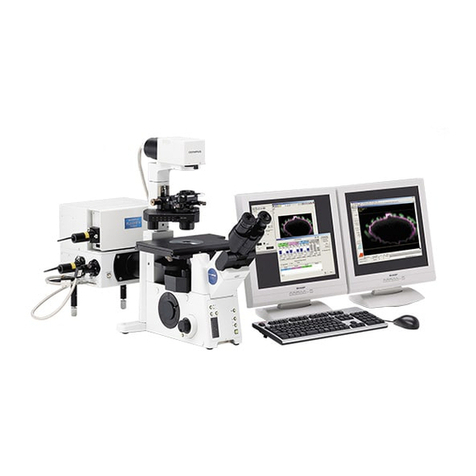Rodenstock REM 4000 User manual

603F9190-0L
INSTRUCTION MANUAL
Specular Microscope
REM 4000
Read this manual thoroughly before using the instrument to
ensure proper and safe operation.
Contact Tomey Corporation or your local distributor if you
have any questions or encounter any issues during
operation.
■
Always follow the operation procedures
described in this manual.
■
Keep this manual in a readily accessible
location while operating the instrument.
■
Contact your local distributor if you lose this
manual.


i-1
■
i Important safety information
■
Do not install this instrument in a location where explosives or flammable
substances are used or stored. Otherwise, fire or explosion may occur.
■
Do not remove the cover of the instrument. Otherwise electric shock may result.
■
Do not disassemble or modify the instrument. Otherwise electric shock may result.
■
Disconnect the power cord from the instrument before servicing the instrument.
Otherwise, electric shock may result.
■
Do not commence service or maintenance work while the instrument is being used
for a patient.
■
Do not place water or chemicals on the instrument. Any water or chemicals
entering the instrument may cause electric shock or failure.
■
Use only the specified data terminal for connection of the instrument. Using
another type of terminal may result in failure of the instrument.
■
This instrument is a diagnostic/capturing device specifically designed for
ophthalmology. Never use the instrument for other purposes.
■
A metal blade is attached to the printer cover. Touching this blade may result in
injuries, so be sure to pay utmost attention when handling the printer cover.
■
The terminals for connecting external devices to the instrument are not isolated
from the internal circuit. Inappropriate wiring may damage the internal circuit.
Contact us or your local distributor when using the instrument connected to
another device.

■
ii-1
ii How to read this manual
Outline
This manual is structured as follows.
1. PRIOR TO USE
Describes safety precautions and important information to be
understood before installing and using the instrument.
2. NAMES AND FUNCTIONS
Describes names and functions of each section of the instrument.
3. OPERATION PROCEDURES
Describes information required for installing and using the instrument.
4. INSPECTION AND MAINTENANCE
Describes procedures for replacing consumable parts, etc. that the
user of the instrument should normally conduct.
5. TROUBLESHOOTING
Describes how to solve problems.
6. CONSUMABLES AND OPTIONAL EQUIPMENT
Describes consumable parts and optional equipment.
7. SPECIFICATIONS
Describes the specifications of the instrument.
Symbols used in this manual
Sentences accompanied by the symbols below indicate the
following:
■
This is a precaution that, if unheeded, will result in a hazardous
situation where there is an imminent danger of serious injury or
death.
■
This is a precaution that, if unheeded, could result in a
hazardous situation where there is a possibility of serious injury
or death.
■
This is a precaution that, if unheeded, may result in a situation
where there is a possibility of minor or moderate injury or
damage to property.
■
This is additional information which may contain special
precautions on company policies related, either directly or
indirectly, to the safety of personnel or to the protection of
property.

iii-1
■
iii Contents
i Important safety information ...................................................................................................................... i-1
ii How to read this manual ........................................................................................................................... ii-2
Outline..........................................................................................................................................................ii-2
Symbols used in this manual .......................................................................................................................ii-2
iii Contents ................................................................................................................................................... iii-1
1. PRIOR TO USE .......................................................................................................................................... 1-1
1.1 Precautions for operation...................................................................................................................... 1-1
1.2 Checking package contents.................................................................................................................. 1-5
1.3 Glossary................................................................................................................................................ 1-6
1.4 Overview ............................................................................................................................................... 1-8
2. NAMES AND FUNCTIONS ........................................................................................................................ 2-1
2.1 Physician's side .................................................................................................................................... 2-1
2.2 Patient's side......................................................................................................................................... 2-2
2.3 Sides of the main unit ........................................................................................................................... 2-3
2.4 Screen................................................................................................................................................... 2-4
2.4.1 Basic structure and standard items................................................................................................ 2-4
2.4.2 Capture screen............................................................................................................................... 2-5
2.4.3 Image selection screen .................................................................................................................. 2-7
2.4.4 Analysis screen .............................................................................................................................. 2-8
2.5 Symbols used for marking .................................................................................................................. 2-11
3. OPERATION PROCEDURES .................................................................................................................... 3-1
3.1 Safety precautions ................................................................................................................................ 3-1
3.2 Preparation before use ......................................................................................................................... 3-1
3.2.1 Connections ................................................................................................................................... 3-1
3.2.2 Starting/shutting down the instrument ........................................................................................... 3-3
3.2.3 Clearing last examination data (preparation for new patient) ........................................................ 3-4
3.2.4 Entering patient data ...................................................................................................................... 3-4
3.2.5 Patient's eye height adjustment ..................................................................................................... 3-6
3.2.6 Setting the fixation light position .................................................................................................... 3-8
3.2.7 Setting capturing conditions ........................................................................................................... 3-8
3.3 How to capture images ....................................................................................................................... 3-10
3.3.1 Selecting eye to be measured ..................................................................................................... 3-10
3.3.2 Alignment ..................................................................................................................................... 3-10
3.3.3 Capturing endothelial images ...................................................................................................... 3-13
3.3.4 Selecting image............................................................................................................................ 3-15
3.4 Analysis............................................................................................................................................... 3-16
3.4.1 Auto Analysis................................................................................................................................ 3-16
3.4.2 L-count method ............................................................................................................................ 3-25
3.4.3 Core method ................................................................................................................................ 3-28
3.5 Export, Print, and Save ....................................................................................................................... 3-31
3.5.1 Exporting ...................................................................................................................................... 3-31
3.5.2 Printing ......................................................................................................................................... 3-33

■
iii-2
3.5.3 Saving .......................................................................................................................................... 3-35
3.6 Database............................................................................................................................................. 3-36
3.6.1 Browsing examination data .......................................................................................................... 3-36
3.6.2 Deleting examination data ........................................................................................................... 3-37
3.6.3 Changing ID ................................................................................................................................. 3-38
3.7 System setup ...................................................................................................................................... 3-40
3.7.1 General ........................................................................................................................................ 3-40
3.7.2 Measurement ............................................................................................................................... 3-43
3.7.3 Application.................................................................................................................................... 3-45
3.7.4 Connection & Print ....................................................................................................................... 3-48
4. INSPECTION AND MAINTENANCE ......................................................................................................... 4-1
4.1 Warranty................................................................................................................................................ 4-1
4.2 Operation life......................................................................................................................................... 4-2
4.3 Inspection.............................................................................................................................................. 4-2
4.4 Routine maintenance ............................................................................................................................ 4-3
4.5 Replacing consumables........................................................................................................................ 4-4
4.5.1 Fuses ............................................................................................................................................. 4-4
4.5.2 Built-in printer paper....................................................................................................................... 4-4
4.6 Storing................................................................................................................................................... 4-6
4.7 Disposal ................................................................................................................................................ 4-6
5. TROUBLESHOOTING ............................................................................................................................... 5-1
5.1 Common items...................................................................................................................................... 5-1
6. CONSUMABLES AND OPTIONAL EQUIPMENT..................................................................................... 6-1
7. SPECIFICATIONS...................................................................................................................................... 7-1
7.1 Specifications........................................................................................................................................ 7-1
7.1.1 Capturing scope ............................................................................................................................. 7-1
7.1.2 Central corneal thickness measurement accuracy ........................................................................ 7-1
7.1.3 Central corneal thickness measurement range ............................................................................. 7-1
7.1.4 Main unit......................................................................................................................................... 7-1
7.2 Operating environment ......................................................................................................................... 7-1
7.3 Classification......................................................................................................................................... 7-1
7.4 Declaration of Conformity to EMC .............................. 7-エラー! ブックマークが定義されていません。

1-1
■
1. PRIOR TO USE
■
Read this manual thoroughly before using the instrument to ensure
proper and safe operation.
■
Always follow the operation procedures as described in this manual.
■
Check that there are no devices that generate a strong magnetic field near
the instrument. A strong magnetic field may cause noise and affect the
capture of images.
1.1 Precautions for operation
Allow only qualified operators to use the instrument.
Precautions when installing the instrument.
-Install the instrument in a location free of water or chemicals. Any water
or chemicals entering the instrument may cause electric shock or failure.
-Do not install the instrument in a location where chemicals are stored or
gases may occur. Spilt chemicals or vapor may enter the instrument and
result in fire.
-Check that the frequency, voltage, and allowable current (or power
consumption) of the power source are appropriate. Otherwise, fire or
electric shock may occur.
-Connect the power plug to a grounded 3-pin outlet. Otherwise, a short
circuit due to failure of the instrument may result in electric shock.
-Do not place any heavy object on the power cord or compress the power
cord. Fire or electric shock may occur.
-Fully insert the power plug into the outlet. Faulty contact, allowing any
metal to contact the exposed terminal of the plug, or dust accumulated
on the exposed terminal of the plug may result in fire or electric shock.
-When operating this instrument connected to other devices, use only
devices that comply with IEC60601-1 or that comply with IEC60950-1 and
whose power source is isolated with an isolation transformer.
Furthermore, all devices should be configured to comply with the
standard IEC60601-1 ME system. Anyone who connects any additional
device to the communication connector will be considered a person
configuring a medical system, and is therefore responsible for complying
with the requirements of an IEC60601-1 ME system. Contact us or your
local distributor before connecting the instrument to another device with
a communication connector.
-Do not connect a device with data transmission specifications that are not
compatible. Fire or electric shock may occur. Contact us or your local
distributor before using the instrument while it is connected to another
device.
-Conduct grounding work correctly. Otherwise electric shock may occur.

■
1-2
-Do not hold the head, chin rest, forehead pad, or joystick when moving
the instrument. These components are detachable and the instrument
may drop, resulting in injuries.
-Install the instrument in a location not subject to direct sunlight, high
temperature and humidity, or air containing dust, salt, and/or sulfur.
Otherwise, failure or malfunction may occur.
-Install the instrument in a level stable location free of vibration or
mechanical impact. Otherwise, images cannot be captured correctly.
Also, the instrument may topple or fall resulting in fire or a serious
accident.
-Install the instrument between the patient and physician so that they can
face each other.
-Install the instrument in a location with ample clearance from other
devices to allow smooth inspection.
Precautions before using the instrument
-Check that the instrument works properly by inspecting switch and button
operations, display, and printing.
-Check that all cables are connected correctly.
-Check the sections that the patient will directly touch.
-Peel off the top sheet of chin rest paper and clean the forehead pad with
a cloth dampened with alcohol before capturing images.
-Check that the instrument is correctly grounded.
-Check that the date set in the instrument conforms to the actual operation
date and time.
Precautions during operation
-Do not place any container with liquid in it on the instrument. Any liquid
entering the instrument may cause electric shock or failure.
-If any smoke, offensive odor, or abnormal sound occurs, turn the
instrument off immediately, disconnect the power plug from the outlet,
and contact us or your local distributor.
-After the power switch is turned on, do not operate the joystick, touch
panel, or membrane button panel during the initial motion performed
before the capture screen appears. If the initial motion is not completed
correctly, malfunction may result when capturing images.
-When moving the head and/or chin rest of the instrument, pay attention
to the position of the patient's face, and patient’s and physician’s hands
and fingers. Otherwise, movement of the head or chin rest may result in
injury.

1-3
■
-Do not allow any person to place their hands or fingers in the clearance
under the head or the section immediately under the chin rest. Injury may
result to hands and fingers.
-Never insert fingers or objects through the capture window. Malfunction
or failure of the instrument or faulty analysis results may occur.
-Do not lean on the instrument or press the instrument from the top. The
instrument may topple over, resulting in mechanical failure or injuries.
-Be careful not to exceed the diagnosis time.
-Always check that the device is operating correctly and monitor the
patient to ensure safety.
-If any problem is found concerning either the instrument or patient, take
appropriate action, such as stopping the device, to ensure patient safety.
-Immediately stop capturing images if the patient shows any signs of
photosensitive epilepsy.
-Faulty fixing of the sight, eyelid drooping, trichiasis, corneal diseases, etc.
may affect the analysis result or measurement of corneal thickness.
When the captured image is unclear, use another image for analysis or
capture another image. If the measurement result of the corneal
thickness is doubtful, review the inspection result by performing
measurement again or perform another inspection.
-When using captured images or analysis results obtained with this
instrument for diagnosis, also refer to the results of other examinations.
Capturing conditions may affect the precision of images or analysis result.
-Do not use the “central corneal thickness” and “ultrasonic correction for
central corneal thickness”output from this instrument to directly correct
the eye refractive power. Other examination methods should also be
used in conjunction with the above.
-Do not allow the patient to touch the instrument.
-Peel off the top sheet of chin rest paper and clean the forehead pad with
a cloth dampened with alcohol before conducting measurements.
Precautions after operation
-Do not place any container with liquid in it on the instrument. Any liquid
entering the instrument may cause electric shock or failure.
-Do not use organic solvents such as thinner, benzene, or acetone to
clean the instrument. Fire or electric shock may occur. (These can also
corrode the resin or coating of the instrument cover.)
-Hold the plug when disconnecting the power plug from the outlet to avoid
placing excessive force on the cord. Pulling the cord may damage the
inner core wires, resulting in electric shock or fire.
-Disconnect the power plug from the outlet to ensure safety when the
instrument is not in operation for long periods.
-Refer to “4.6 Storing” for instructions on the storage of the instrument.

■
1-4
-Clean the instrument at the end of operation in preparation for the next
use.
-Clean and neatly arrange the accessories and cables.
If any failure occurs in the instrument, immediately stop operation, identify the failure in
the instrument, and contact your local distributor for repairs.
-Do not modify the instrument. Touching the internal circuit may result in
death or serious injuries.
-Disconnect the power plug from the outlet when replacing fuses.
Otherwise, electric shock may occur, resulting in death or serious injuries.
-Use the power cord and fuses provided with the instrument or specified
by Tomey to ensure safety. Also, do not use the accessories provided
with the instrument for other equipment.
-When any failure occurs in the instrument, identify the failure in the
instrument and contact your local distributor for inspection and repairs.
Do not attempt to repair the instrument yourself.
-Conduct regular inspections of the instrument and components.
-When the instrument has not been in use for 1 month or longer, check
that the instrument is operating correctly and safely before starting
operation. Refer to “4.3 Inspection” in this manual for the checking
procedures.

1-5
■
1.2 Checking package contents
■
Keep the box and packing materials for use when moving or transporting the
instrument.
■
When taking the instrument out of the box, pull the outer box upward and then
remove the packing materials. Be careful not to lift the instrument by directly
holding the head, chin rest, forehead pad, or joystick. The instrument may be
damaged.
Open the package and check that the required quantity of the following items is
included and they are not damaged. If any item is missing or damaged, contact
your local distributor as soon as possible.
Main unit SPECULAR MICROSCOPE EM-4000 ........................................ 1
Power cord ................................................................................................... 1
Touch pen .................................................................................................... 1
SD card (installed in the main unit) .............................................................. 1
Fuse (2 fuses are installed in the main unit.) ............................................... 4
Chin rest paper ............................................................................................ 1
Pins for chin rest paper ................................................................................ 2
Printer paper (1 paper is installed in the main unit.) .................................... 2
Dust cover .................................................................................................... 1
Instruction manual (this manual) ................................................................. 1
Data Transfer installation CD ...................................................................... 1
Data Transfer Starting Guide ....................................................................... 1

■
1-6
1.3 Glossary
[6A]
:
Percentage of cell hexagonality.
Percentage of hexagonal cells in analyzed endothelium
[AA/AS]
:
Auto Alignment / Auto Shot
[AA/MS]
:
Auto Alignment / Manual Shot
[AVG]
:
Average area
Average area of cells in the analyzed endothelium
[Basic mode]
:
Capture mode in which the image selection screen appears when capturing
is completed.
This mode is for users to select a single image from 16 captured images of
endothelium.
[CCT]
:
Central corneal thickness
[CCT (US)]
:
Ultrasound correction for central corneal thickness
The reference value expected when measuring the same central corneal
thickness using our ultrasound pachymeter
[CD]
:
Cell density
The number of analyzed cells in 1 mm2
[Core method]
:
Analysis method to calculate values such as CD (cell density) by extracting
outlines of cells referring to the center of the cell entered by the physician
[CV]
:
Coefficient of variation
A value calculated by dividing the standard deviation of cell areas with the
average area of the cells.
[D.A.AVG]
:
Average size of Dark Area
The average area of the sizes of Dark Area analyzed.
[D.A.CV]
:
Coefficient of variation of Dark Area
A value calculated by dividing the standard deviation of Dark Area sizes by
their average size.
[D.A.Density]
:
Dark Area density
The number of analyzed Dark Areas in 1 mm2
[D.A.MAX]
:
The maximum size of Dark Area
The area of the largest Dark Area analyzed
[D.A.MIN]
:
The minimum size of Dark Area
The area of the smallest Dark Area analyzed
[D.A.NUM]
:
Number of Dark Areas analyzed
[D.A.Ratio]
:
Dark Area ratio
Ratio of the sum of the Dark Area relative to the total area analyzed. The
total area is the sum of the analyzed Dark Area and the area of the
analyzed endothelial cells.
[D.A.SD]
:
Standard deviation of Dark Area
Standard deviation of the sizes of the Dark Area analyzed
[DATA Transfer]
:
System to output the examination data obtained with our product as a file

1-7
■
[Dark Area]
:
A black circled region to be observed by specular microscope
[Dark Area analysis]
:
Analysis method to calculate values related to the Dark Area (D.A.Density,
etc.) by automatically extracting Dark Areas from the captured image
[L-count method]
:
Analysis method to calculate values such as CD (cell density) according to
the area and points in the cells entered by the physician
[MA/MS]
:
Manual Alignment / Manual Shot
[MAX]
:
Maximum area
The area of the largest cell in the analyzed endothelium
[MIN]
:
Minimum area
The area of the smallest cell in the analyzed endothelium
[NUM]
:
Number of cells counted
The number of cells in the analyzed endothelium
[Quick mode]
:
Capture mode in which the image selection screen does not appear when
capturing is completed
This mode is for users who do not wish to observe 16 images of
endothelium.
[SD]
:
Standard deviation
Standard deviation of the area of cells in the analyzed endothelium
[TOMEY Link]
:
System for electronic medical records that controls the examination data
obtained with Tomey products
[Auto Alignment]
:
Function to automatically align the camera in up/down/right/left/focus
directions
[Auto Shot]
:
Function to automatically capture an image when the camera in the
up/down/right/left/focus directions is optimized
[Auto Analysis]
:
Analysis method to calculate values such as CD (cell density) by
automatically extracting outlines of cells on the captured image
[Power-save]
:
This is a function to automatically turn off the monitor when the instrument
is not operated for a specified time. Touch the monitor to return to normal
status.
[Touch Alignment]
:
Function to move the measuring head by touching the screen. This is used
for approximate alignment.
[Manual Alignment]
:
Function to manually align the camera in up/down/right/left/focus directions
[Manual Shot]
:
Function to manually capture an image when the camera in the
up/down/right/left/focus directions is optimized
[Rx only]
:
This symbol on the label of this device states “Caution: Federal law restricts
this device to sale by or on the order of a licensed healthcare practitioner.”

■
1-8
1.4 Overview
This instrument is designed to observe and analyze corneal endothelium by capturing its
image without making contact, analyzing the captured image, and calculating data such as
cell density. In addition, this instrument also measures the central corneal thickness while
capturing an image of corneal endothelium.
The patient places their chin on the chin rest and looks into the Fixation Light in the capture
window. The instrument automatically starts fine alignment when the physician aligns the
corneal center and captures an image. An image can be captured manually using the
joystick if a problem with the eyes makes automatic operation impossible.

2-1
■
2. NAMES AND FUNCTIONS
2.1 Physician's side
(1) LCD monitor and touch panel
Displays some screens. Touch displayed
buttons to operate the instrument.
The tilting angle of the monitor can be adjusted.
(2) Power lamp
The lamp stays lit while the power is turned ON.
(3) Chin rest up/down button
Press the button to move the chin rest up and
down.
(4) Joystick
Used for alignment.
Use the capture button on the top of the
joystick when capturing an image manually.
(5) Built-in printer
A thermal printer with an automatic cutter.
Prints the examination data.
(5)
Head
Base
Neck
(1)
(2)
(3)
(4)

■
2-2
2.2 Patient's side
(1) Touch pen
Use this when selecting cells etc. The touch
pen includes a magnet and can be attached to
the side of the monitor.
(2) Forehead rest and pad
Have the patient lightly press their forehead to
this pad to stabilize their head while capturing
an image.
(3) Capture window
Radiates light for capturing images and
receives the light reflected from the patient’s
eye.
(4) Chin rest
Have the patient place his/her chin on this rest.
(1)
(2)
(3)
(4)

2-3
■
2.3 Sides of the main unit
(1) Power socket
Connect the power cord here.
(2) Power switch
Turns the instrument on and off.
(3) Packing button
Holding this button for 3 seconds moves the
head to a set position in preparation for
packing.
(4) SD card slot
An SD card used to save the examination data
is inserted here.
(5) USB-H connector
Connect the video printer and external ID input
device here.
(6) USB-D connector (PICT)
Connect the Pict Bridge printer here.
(7) USB-D connector (PC)
Connect the personal computer etc. here.
(8) LAN connector
Used for connection to the Ethernet.
(9) Maintenance switch
Our maintenance personnel use this switch
when servicing the instrument.
Never touch this switch.
(1)
(2)
(3)
(4)
(5)
(6)
(7)
(8)
(9)

■
2-4
(3)
(2)
(1)
(4)
(5)
(6)
Varies depending on modes
2.4 Screen
2.4.1 Basic structure and standard items
(1) Patient information button
Moves to the patient information input screen.
(2) Patient information field
Displays the ID and name of the patient.
(3) Version
Displays the version of the system.
(4) “Database” button
Displays the Patient List screen.
(5) “Retake” button
Touch and hold this button to delete the examination data of the selected patient’s eye and
start capturing another image.
(6) “New” button
Touch and hold this button to delete the examination data of both eyes and the patient’s
information, and start capturing an image.

2-5
■
2.4.2 Capture screen
(1) Eye selection button
Display left or right eye according to the device head placement. Touch these buttons to move
the instrument head right and left.
(2) Thumbnails
Display the captured images of the endothelium, anterior segment, and central corneal
thickness.
(3) Alignment/capture setting
Displays the setting for alignment and capture.
- AA/AS: Auto Alignment / Auto Shot
- AA/MS: Auto Alignment / Manual Shot
- MA/MS: Manual Alignment / Manual Shot
(4) Light Power setting
Displays the setting for the light strength for capturing an image of the endothelium.
- Auto: Brightness is automatically adjusted.
- High: Maximum brightness
- Low: Minimum brightness
(5) Auto Alignment ring
Displayed when Auto Alignment is ON.
(6) Focus indicator
Displays the distance between the head and the patient's eye.
- Horizontal bars mean that the head is too far from the eye.
- Vertical bars mean that the head is too close to the eye.
(1)
(11)
(4)
(5)
(6)
(7)
(2)
(8)
(3)
(9)
(12)
(13)
(10)
(14)
(1)
(2)

■
2-6
(7) Auto shot mark
Shown in auto shot mode.
(8) Alignment OK mark
Shown when alignment is optimum.
(9) Fixation light button
The preset fixation light position is shown in orange on this button.
Touch this button to open the Fixation screen.
(10) “Setup” button
Moves to the Setup screen.
(11) “Analyze” button
Performs automatic analysis and moves to the R/L eye analysis screen.
(12) Head retract button
The head retracts while this button is touched.
(13) “ZoomIn” button
Switches the image shown by the live camera from the anterior chamber to endothelium.
This button appears in MS (Manual Shot) mode.
(14) Image selection button
Moves to the image selection screen.
Table of contents
Other Rodenstock Microscope manuals
